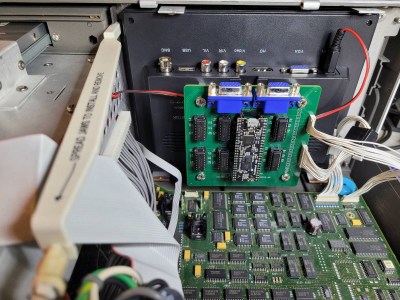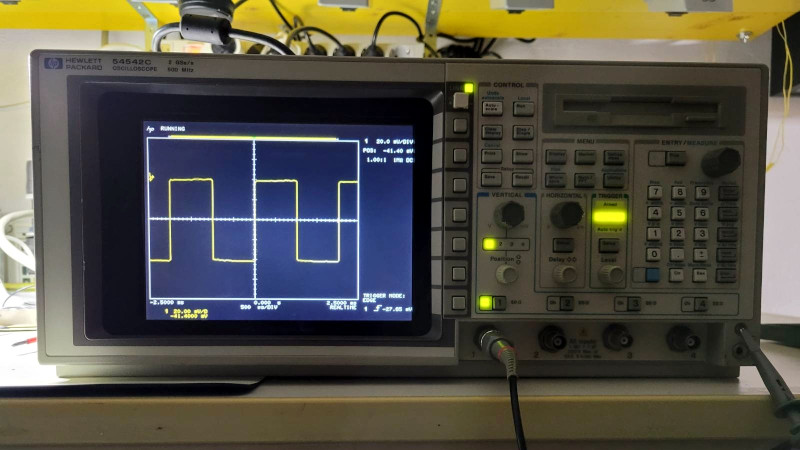Although the HP 54542C oscilloscope and its siblings are getting on in years, they’re still very useful today. Unfortunately, as some of the first oscilloscopes to switch from a CRT display to an LCD they are starting to suffer from degradation. This has led to otherwise perfectly functional examples being discarded or sold for cheap, when all they need is just an LCD swap. This is what happened to [Alexander Huemer] with an eBay-bought 54542C.
Although this was supposed to be a fully working unit, upon receiving it, the display just showed a bright white instead of the more oscilloscope-like picture. A short while later [Alexander] was left with a refund, an apology from the seller and an HP 54542C scope with a very dead LCD. This was when he stumbled over a similar repair by [Adil Malik], right here on Hackaday. The fix? Replace the LCD with an FPGA and VGA-input capable LCD.
 While this may seem counter intuitive, the problem with LCD replacements is the lack of standardization. Finding an 8″, 640×480, 60 Hz color LCD with a compatible interface as the one found in this HP scope usually gets you salvaged LCDs from HP scopes, which as [Alexander] discovered can run up to $350 and beyond for second-hand ones. But it turns out that similar 8″ LCDs are found everywhere for use as portable displays, all they need is a VGA input.
While this may seem counter intuitive, the problem with LCD replacements is the lack of standardization. Finding an 8″, 640×480, 60 Hz color LCD with a compatible interface as the one found in this HP scope usually gets you salvaged LCDs from HP scopes, which as [Alexander] discovered can run up to $350 and beyond for second-hand ones. But it turns out that similar 8″ LCDs are found everywhere for use as portable displays, all they need is a VGA input.
Taking [Adil]’s project as the inspiration, [Alexander] used an UPduino v3.1 with ICE40UP5K FPGA as the core LCD-to-VGA translation component, creating a custom PCB for the voltage level translations and connectors. One cool aspect of the whole system is that it is fully reversible, with all of the original wiring on the scope and new LCD side left intact. One niggle was that the scope’s image was upside-down, but this was fixed by putting the new LCD upside-down as well.
After swapping the original cooling fan with a better one, this old HP 545452C is now [Alexander]’s daily scope.
















Put in an external monitor port so the display can be enbiggened for people who need reading glasses to use their computer.
VGA splitter, a decent one, would allow both internal and external display. But you’d still be limited to 640×480 resolution. On a 32″ LCD that can preserve the old 4:3 ratio, that’d result in an image about 30 pixels per inch.
An external monitor port is part of the design, as documented on github.
This is one of those solutions that both annoys and pleases me simultaneously.
The perfect case (pun not intended) for a solution like this: it looks like there’s plenty of room for the slew of daisychained converting and reconverting circuitry involved… The display itself can even remain in its original housing! The reversibility is awesome. It keeps the machine out of eWaste, and quickly. But also the new display and plausibly the FPGA converter could later be repurposed as well if this machine ever gets an original replacement LCD (but, maybe, why bother?)… And Gregg makes a good point, too, it’s not only a fix, but a potential upgrade.
Definitely not the way I’d’ve gone about replacing the dead LCD… But, heck… Why Not? I think I learned something today. It may be a bunch of “off the shelf” parts, combined with good-ol’ engineering, but I think I can also say “This is a hack.”
As an owner of a new-to-me HP54540A with a CRT display, I’m looking forward to more mods like this one.
Don’t expect current-day performance from these scopes though – their processor (handling the user interface, comms, FFT, …) is dog slow.
Don’t forget they have Tetris built in and it’s a really good implementation you control with the knobs. When i worked at HP Agilent i played so much with these. And did proper work too.
Nice to see old but useful gear kept alive. I have an HP 16500 that could use an LCD instead of the failing CRT.
I mean if you going fpga, could just use an ips or lvds lcd instead, just need some level shifting, buffers and a fpc or flex connector
Well in hindsight it does allow you to hook it to a TV or external monitor aswell….
Old LCDs used fluorescent backlighting that failed after a few years. Sometimes, they can be “fixed” with an LED backlight — the article made no mention of how the LCD failed. I recall at my last job when the LCD backlight was no longer available, we switched to an lower power but brighter LED backlight that was also cheaper and didn’t use mercury!
Wondering if a Rp2040 chip could do same?
Very nice PCB on this one, he could sell drop in replacements!